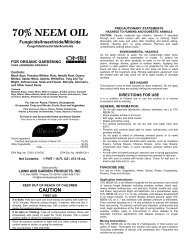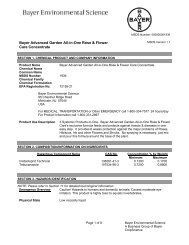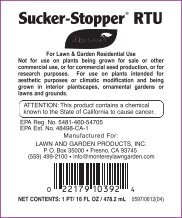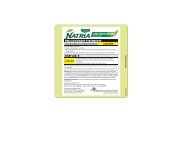EverGreen Pyrethrum Dust Technical Bulletin - MGK
EverGreen Pyrethrum Dust Technical Bulletin - MGK
EverGreen Pyrethrum Dust Technical Bulletin - MGK
Create successful ePaper yourself
Turn your PDF publications into a flip-book with our unique Google optimized e-Paper software.
PYRETHRUM DUST<br />
<strong>EverGreen</strong> ® <strong>Pyrethrum</strong> <strong>Dust</strong> is a botanical insecticide dust that delivers<br />
fast kill for a broad range of target pests, including Bed Bugs.<br />
• Contains pyrethrum – a botanical insecticide derived from a<br />
chrysanthemum-like flower<br />
• Controls over 230 insects and pests including Bed Bugs, Fleas, Ants,<br />
German Cockroaches, Yellow Jackets, and Wasps<br />
• Indoor and outdoor use<br />
• OMRI listed for organic facilities<br />
Product Specifications Use Areas<br />
Signal Word Caution<br />
Packaging 10 oz. dusting bottle (6 per case),<br />
3 lb. dusting bottle (2 per case)<br />
EPA Registration Number 1021-1871<br />
Food Handling For use in food and non-food areas<br />
Stability of Undiluted Product Not applicable – dust<br />
Stability of Diluted Product Not applicable – dust<br />
Appearance Off-white colored powder<br />
Odor Slight odor of pyrethrum<br />
Active Ingredients Pyrethrins<br />
Flammability Classified as a non-combustible solid<br />
Mode of Action Sodium channel modulator – disrupts<br />
insects’ nervous system<br />
Class of Chemistry Pyrethrins<br />
Respirator Required Not required<br />
Mix or Dilute in Use alone – do not mix with other<br />
dusts or insecticides<br />
Activity Contact kill and flushing<br />
Shelf Life 2 years in original commercial<br />
packaging<br />
®<br />
Indoors in Food and Non-food Areas,<br />
such as:<br />
Homes<br />
Apartments<br />
Hotels<br />
Restaurants<br />
Food processing facilities<br />
OMRI-certified facilities<br />
Stored product areas<br />
Wall voids<br />
Voids in attics<br />
In and Around Animal and Livestock<br />
Facilities including:<br />
Beef barns<br />
Dairies and dairy barns<br />
Horse stables and barns<br />
Poultry houses<br />
On-animal Use for the Following<br />
Domestic Animals:<br />
Beef cattle<br />
Dairy cattle<br />
Horses and other livestock<br />
Outdoor Use in and Around Areas, such as:<br />
Beneath decks building<br />
Perimeters<br />
Gardens<br />
Kennels<br />
Nurseries<br />
Outdoor eating facilities<br />
TECHNICAL BULLETIN
Indoor and Outdoor Use on Landscape/<br />
Ornamental Plants Method of Application<br />
Method of Application<br />
• Void treatment.<br />
• Crack and crevice treatment.<br />
• Spot treatment up to 2 feet x 2 feet.<br />
• Building perimeter treatment.<br />
• Use bottle dust applicator, hand pump duster,<br />
bulbous duster, or other hand-operated<br />
duster. Do not use power duster.<br />
Best Practices when using<br />
<strong>EverGreen</strong> ® <strong>Pyrethrum</strong> <strong>Dust</strong><br />
Use <strong>EverGreen</strong> <strong>Pyrethrum</strong> <strong>Dust</strong> as part of<br />
an IPM program<br />
Use <strong>EverGreen</strong> <strong>Pyrethrum</strong> <strong>Dust</strong> in conjunction<br />
with other IPM strategies including the use of<br />
Onslaught ® Microencapulated Insecticide and<br />
Bedlam ® Insecticide for Bed Bugs.<br />
Apply this product only as specified on<br />
the package label<br />
During application, do not apply this product in<br />
a way that will contact adults, children, or pets,<br />
either directly or indirectly through drift.<br />
Remove pets, birds, and cover fish<br />
aquariums before application<br />
Clean-up<br />
For indoor spot treatments in areas that adults,<br />
children, or pets could come in direct contact<br />
with the product, vacuum up remaining dust<br />
and dead insects after treatment.<br />
Outdoors<br />
• Do not apply directly to or near water, storm<br />
drains, or drainage ditches.<br />
• Do not apply when windy.<br />
• Before widespread application to plants,<br />
evaluate the phytotoxicity to plants by<br />
treating and observing a limited number<br />
of plants for 10 days.<br />
Key Insects and Pests Controlled<br />
<strong>EverGreen</strong> <strong>Pyrethrum</strong> <strong>Dust</strong> is labeled for<br />
control of insects and pests including:<br />
Adelgids<br />
Alfalfa Weevil<br />
Almond Moth<br />
American Black Flour Beetle<br />
Angoumois Grain Moths<br />
Ants<br />
Aphids<br />
Apple Maggot<br />
Always read and follow label and<br />
MSDS directions.<br />
To learn more, visit www.mgk.com,<br />
call 1-800-645-6466<br />
or send an e-mail to brands@mgk.com.<br />
PYRETHRUM DUST<br />
8810 Tenth Avenue North, Minneapolis, MN 55427<br />
2.5M-0412<br />
®<br />
Armyworms<br />
Asian Cerambycid Beetles<br />
Asian Lady Beetle<br />
Asian Pine Tip Moths<br />
Bagworm<br />
Barn Flies<br />
Bat Bugs<br />
Bean Beetles<br />
Bean Weevils<br />
Bed Bugs<br />
Bees<br />
Beet Armyworms<br />
Beetles<br />
Birch Leafminer<br />
Black Carpet Beetles<br />
Black Fungus Beetles<br />
Black Turpentine Beetles<br />
Black Vine Weevil<br />
Blacklegged Tick Nymphs<br />
Blister Beetles<br />
Blow Flies<br />
Booklice<br />
Bottle Flies<br />
Boxelder Bugs<br />
Broadhorned Flour Beetles<br />
Broadnosed Grain Weevils<br />
Brown Spider Beetles<br />
Brown Spruce Longhorn Beetle<br />
Budworms<br />
Bugs<br />
Cadelles<br />
California Oakworm<br />
Cankerworms<br />
Carpet Beetles<br />
Carrion Beetles<br />
Carrot Weevil<br />
Caterpillars<br />
Catorama Beetles<br />
Centipedes<br />
Cereal Beetles<br />
Cheese Mites<br />
Cheese Skippers<br />
Chicken Mites<br />
Chocolate Moths<br />
Chrysanthemum Leaf Miners<br />
Cicadas<br />
Cigarette Beetle<br />
Clearwing Borer<br />
Clothes Moths<br />
Clover Mites<br />
Clover Weevil<br />
Cluster Flies<br />
Cocoa Bean Moths<br />
Coffee Bean Weevils<br />
Cone Beetles<br />
Cone Worms<br />
Confused Flour Beetle<br />
Conifer Spider Mite (adult)<br />
Corn Sap Beetles<br />
Cottonwood Borer<br />
Cottonwood Leaf Beetles<br />
Cranbury Girdlers<br />
Crane Flies<br />
Crickets<br />
Cross-striped Cabbageworm<br />
Cucumber Beetles<br />
Cutworms (exposed)<br />
Dark Mealworms<br />
Darkling Beetles<br />
(lesser meal worm)<br />
Deer Tick<br />
Depressed Flour Beetles<br />
Dermestid Beetles<br />
Diamondback Larvae<br />
Dingy Cutworm Adult<br />
Douglas Fir Midge<br />
Douglas Fir Tussock Moth<br />
Drain Flies<br />
Dried Fruit Beetles<br />
Drugstore Beetles<br />
Earwigs<br />
Eastern Tent Caterpillar<br />
Elmleaf Beetle<br />
Emerald Ash Borer<br />
European Grain Moths<br />
European Pine Shoot Moth<br />
European Pine Tip Moth<br />
Face Flies<br />
Fall Cankerworms<br />
Fall Webworm<br />
Fannia Flies<br />
Field Crickets<br />
Firebrats<br />
Fireworms<br />
Flat Grain Beetles<br />
Flea Beetles<br />
Fleas<br />
Flies<br />
Flying Moths<br />
Foreign Grain Beetles<br />
Forest Tent Caterpillar<br />
Fruit Flies<br />
Fruittree Leafroller<br />
Fungus Beetles<br />
Fungus Gnats<br />
German Cockroaches<br />
Giant Root Aphid<br />
Glassy Winged Sharpshooter<br />
Grain Mites<br />
Granary Insects<br />
Granary Weevils<br />
Grape Leaf Skeletonizer<br />
Grape Leafhopper<br />
Grasshoppers<br />
Green Fruit Worm<br />
Green Peach Aphid<br />
Greenbugs<br />
Greenhouse Thrips<br />
Ground Beetles<br />
Gypsy Moth (adults & larvae)<br />
Hairy Fungus Beetles<br />
Hairy Spider Beetles<br />
Harlequin Bug<br />
Heliothis spp.<br />
Hessian Fly (adult)<br />
Hide Beetles<br />
Hornworm<br />
Inchworm<br />
Indian Meal Moth<br />
Iris Borer<br />
Japanese Beetle<br />
Katydids<br />
Khapra Beetles<br />
Lace Bugs<br />
Large Black Flour Beetles<br />
Larger Cabinet Beetles<br />
Larger Grain Borers<br />
Leafhoppers<br />
Leafminers<br />
Leafrollers<br />
Leaftiers<br />
Lesser Grain Beetles<br />
Lesser Grain Borers<br />
Lesser Meal Worm<br />
Lesser Peach Tree Borer<br />
Longheaded Flour Beetles<br />
Loopers<br />
Lygus Bugs<br />
Maize Weevils<br />
Mealy Bugs<br />
Mediterranean Flour Moths<br />
Merchant Grain Beetles<br />
Mexican Bean Beetle<br />
Mexican Grain Beetles<br />
Millers<br />
Millipedes<br />
Mimosa Webworm<br />
Mole Crickets<br />
Moth Flies<br />
Murmidius Beetles<br />
Mushroom Flies<br />
Nantucket Pine Tip Moth<br />
Northern Fowl Mites<br />
Onion Maggot<br />
Palmetto Bug<br />
Peach Twig Borer<br />
Pear Psylla<br />
Pillbugs<br />
Pine Bark Beetles<br />
Pine Engraver<br />
Pink Scavenger Caterpillars<br />
Pinworms<br />
Plant Bugs<br />
Plum Curculio<br />
Ponderosa Pine Needle Miner<br />
Poultry Lice<br />
Powder Post Beetles<br />
Psocids<br />
Psyllids<br />
Red Flour Beetles<br />
Red Gum Lerp Psyllid<br />
Red Horned Grain Beetles<br />
Red Lily Beetles<br />
Red Oak Borer<br />
Redbanded Leafroller<br />
Rice Flour Beetles<br />
Rice Moths<br />
Rice Weevils<br />
Root Weevils<br />
Rose Chafer<br />
Royal Palm Bugs<br />
Rusty Grain Beetles<br />
Saw Flies<br />
Saw-tooth Grain Beetle<br />
Scale (Crawlers)<br />
Seedbugs<br />
Silverfish<br />
Skipper Flies<br />
Skippers<br />
Slenderhorned Flour Beetles<br />
Small Flying Moths<br />
Small Fruit Flies<br />
Smalleyed Flour Beetles<br />
Southern Pine Beetles<br />
Southern Red Mite (adult)<br />
Sowbugs<br />
Spider Beetles<br />
Spider Mites<br />
Spruce Mite (adult)<br />
Squarenecked Grain Beetles<br />
Stable Flies<br />
Stalk Borers<br />
Stink Bugs<br />
Stored Product Pests<br />
Subtropical Pine Tip Moth<br />
Sycamore Leaf Beetle<br />
Tarnished Plant Bug<br />
Tent Caterpillar<br />
Thrips<br />
Tobacco Moths<br />
Trogoderma Beetles<br />
Two-Banded Beetles<br />
Vegetable Leaf Miners<br />
Vinegar Flies<br />
Warehouse Beetles<br />
Wasps [Yellow Jackets, Hornets,<br />
and Paper Wasps]<br />
Waterbugs<br />
Webworms<br />
Weevils<br />
Western Pine Tip Moth<br />
White Apple Leafroller<br />
White Marked Spider Beetles<br />
Whiteflies<br />
Wireworms<br />
Yellow Mealworms<br />
TECHNICAL BULLETIN<br />
<strong>EverGreen</strong> is a registered trademark of <strong>MGK</strong>. All other marks are property of their respective holders. Manufactured by <strong>MGK</strong> ® .<br />
©2012 <strong>MGK</strong>. All rights reserved.








